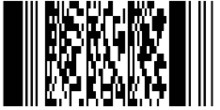PDF417
PDF417 (PDF stands for "Portable Data File") is a 2D barcode and was developed in 1991 by Ynjiun Wang at Symbol Technologies .
The stacked barcode types require complete congruence of scan line and code symbol or code line when reading . This restriction reduces the achievable information density, since larger code heights have to be printed than appears necessary from a theoretical point of view.
The PDF417 code takes this into account, as the code structure takes account of the automatic registration and processing of line changes by means of oblique scanning and makes it manageable. This makes it possible to achieve a drastic reduction in the code height of the printed code and, accordingly, a significant increase in the information density, despite the actually existing angular tolerances during the scanning process.
The properties of this coding are summarized:
- automatic line skip discrimination,
- Possibility of error correction ,
- Separation of channel and source coding via separate assignment tables,
- application-specific configuration of the code redundancy (security levels ).
Code PDF417 defines the three standard operating modes : ASCII , binary mode and numerical mode and contains a further nine user-specific operating modes. In the ASCII mode a code word encodes two alphanumeric characters, in the numeric mode it even encodes three digits.
The basis of the PDF417 is a (17,4,6) source coding with four bars and four spaces, divided into 17 modules. The maximum element width is six modules. A PDF417 print can contain a maximum of 2000 8-bit characters. A typical print is 3–4 square inches in size and achieves a typical data density of 100 to 300 bytes per square inch (corresponds to 15.5 to 46.5 bytes per cm²).
The available patterns are divided into three groups called clusters . Code words that are arranged in the same line come from the same group. A cluster type is repeated every third line. This line marking realizes the automatic line discrimination. When scanning at an angle, the decoder of the reader registers the change in code group (cluster) and takes this into account when interpreting the information read. The restriction of a complete scan of a line of code is thus reduced to the scan of a complete character.
As a further coding-related property, PDF417 has the option of error detection and correction. For this purpose, a PDF417 reading symbol contains two check words for error detection and a variable number of correction words . The data backup can be configured in nine stages. Level 0 does not allow any correction (i.e. only error detection), level 8 allows the complete reconstruction of a maximum of 510 destroyed code words for a read symbol consisting of 925 code words. However, this security level causes a reduction in the information density through the insertion of check words.
use
The code type is used by the Employment Agency, among others , to prevent the manipulation (on the date of dispatch) of questionnaires , as well as on boarding passes in air traffic, on lottery receipts and on certificates of incapacity for work for machine readability by the health insurance companies. Machine-readable ID cards from numerous countries use information in PDF417 to encode information such as fingerprints or similar.
Web links
- Decoder for PDF417 (output in Raw Bytes, Hex, Processed) (English)
- Open source code for generating PDF417
Individual evidence
- ↑ IT in medical practices - Technical Manual Blankoformularbedruckung, KBV_ITA_VGEX_Technisches_Handbuch_BFB , Department digitization and IT, National Association of Statutory Health Insurance Physicians , Version 4.31, May 3, 2018. Retrieved on September 26, 2018

